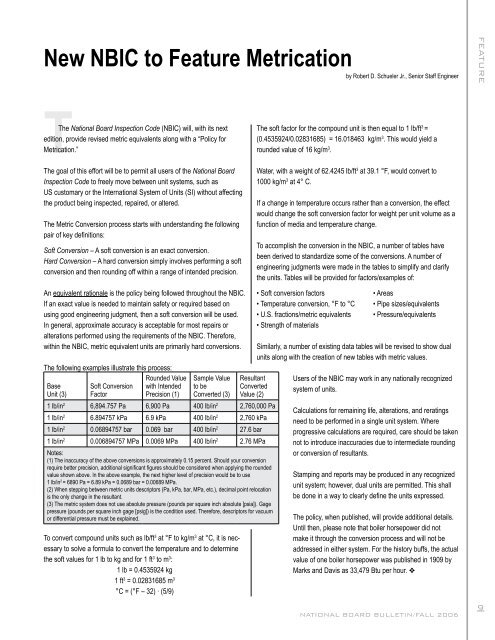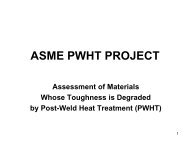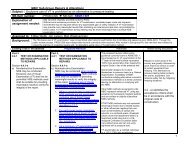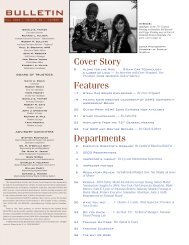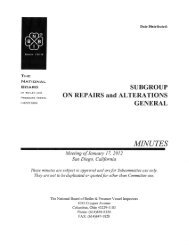bulletin - The National Board of Boiler and Pressure Vessel Inspectors
bulletin - The National Board of Boiler and Pressure Vessel Inspectors
bulletin - The National Board of Boiler and Pressure Vessel Inspectors
You also want an ePaper? Increase the reach of your titles
YUMPU automatically turns print PDFs into web optimized ePapers that Google loves.
New NBIC to Feature Metrication by Robert D. Schueler Jr., Senior Staff Engineer<br />
<strong>The</strong> <strong>National</strong> <strong>Board</strong> Inspection Code (NBIC) will, with its next<br />
edition, provide revised metric equivalents along with a “Policy for<br />
Metrication.”<br />
<strong>The</strong> goal <strong>of</strong> this effort will be to permit all users <strong>of</strong> the <strong>National</strong> <strong>Board</strong><br />
Inspection Code to freely move between unit systems, such as<br />
US customary or the International System <strong>of</strong> Units (SI) without affecting<br />
the product being inspected, repaired, or altered.<br />
<strong>The</strong> Metric Conversion process starts with underst<strong>and</strong>ing the following<br />
pair <strong>of</strong> key definitions:<br />
S<strong>of</strong>t Conversion – A s<strong>of</strong>t conversion is an exact conversion.<br />
Hard Conversion – A hard conversion simply involves performing a s<strong>of</strong>t<br />
conversion <strong>and</strong> then rounding <strong>of</strong>f within a range <strong>of</strong> intended precision.<br />
An equivalent rationale is the policy being followed throughout the NBIC.<br />
If an exact value is needed to maintain safety or required based on<br />
using good engineering judgment, then a s<strong>of</strong>t conversion will be used.<br />
In general, approximate accuracy is acceptable for most repairs or<br />
alterations performed using the requirements <strong>of</strong> the NBIC. <strong>The</strong>refore,<br />
within the NBIC, metric equivalent units are primarily hard conversions.<br />
<strong>The</strong> following examples illustrate this process:<br />
Base<br />
Unit (3)<br />
S<strong>of</strong>t Conversion<br />
Factor<br />
Rounded Value<br />
with Intended<br />
Precision (1)<br />
Sample Value<br />
to be<br />
Converted (3)<br />
Resultant<br />
Converted<br />
Value (2)<br />
1 lb/in2 6,894.757 Pa 6,900 Pa 400 lb/in2 2,760,000 Pa<br />
1 lb/in2 6.894757 kPa 6.9 kPa 400 lb/in2 2,760 kPa<br />
1 lb/in2 0.06894757 bar 0.069 bar 400 lb/in2 27.6 bar<br />
1 lb/in2 0.006894757 MPa 0.0069 MPa 400 lb/in2 2.76 MPa<br />
Notes:<br />
(1) <strong>The</strong> inaccuracy <strong>of</strong> the above conversions is approximately 0.15 percent. Should your conversion<br />
require better precision, additional significant figures should be considered when applying the rounded<br />
value shown above. In the above example, the next higher level <strong>of</strong> precision would be to use<br />
1 lb/in 2 = 6890 Pa = 6.89 kPa = 0.0689 bar = 0.00689 MPa.<br />
(2) When stepping between metric units descriptors (Pa, kPa, bar, MPa, etc.), decimal point relocation<br />
is the only change in the resultant.<br />
(3) <strong>The</strong> metric system does not use absolute pressure (pounds per square inch absolute [psia]). Gage<br />
pressure (pounds per square inch gage [psig]) is the condition used. <strong>The</strong>refore, descriptors for vacuum<br />
or differential pressure must be explained.<br />
To convert compound units such as lb/ft3 at °F to kg/m3 at °C, it is necessary<br />
to solve a formula to convert the temperature <strong>and</strong> to determine<br />
the s<strong>of</strong>t values for 1 lb to kg <strong>and</strong> for 1 ft3 to m3 :<br />
1 lb = 0.4535924 kg<br />
1 ft3 = 0.02831685 m3 °C = (°F – 32) ∙ (5/9)<br />
<strong>The</strong> s<strong>of</strong>t factor for the compound unit is then equal to 1 lb/ft 3 =<br />
(0.4535924/0.02831685) = 16.018463 kg/m 3 . This would yield a<br />
rounded value <strong>of</strong> 16 kg/m 3 .<br />
Water, with a weight <strong>of</strong> 62.4245 lb/ft 3 at 39.1 °F, would convert to<br />
1000 kg/m 3 at 4° C.<br />
If a change in temperature occurs rather than a conversion, the effect<br />
would change the s<strong>of</strong>t conversion factor for weight per unit volume as a<br />
function <strong>of</strong> media <strong>and</strong> temperature change.<br />
To accomplish the conversion in the NBIC, a number <strong>of</strong> tables have<br />
been derived to st<strong>and</strong>ardize some <strong>of</strong> the conversions. A number <strong>of</strong><br />
engineering judgments were made in the tables to simplify <strong>and</strong> clarify<br />
the units. Tables will be provided for factors/examples <strong>of</strong>:<br />
• S<strong>of</strong>t conversion factors • Areas<br />
• Temperature conversion, °F to °C • Pipe sizes/equivalents<br />
• U.S. fractions/metric equivalents • <strong>Pressure</strong>/equivalents<br />
• Strength <strong>of</strong> materials<br />
Similarly, a number <strong>of</strong> existing data tables will be revised to show dual<br />
units along with the creation <strong>of</strong> new tables with metric values.<br />
Users <strong>of</strong> the NBIC may work in any nationally recognized<br />
system <strong>of</strong> units.<br />
Calculations for remaining life, alterations, <strong>and</strong> reratings<br />
need to be performed in a single unit system. Where<br />
progressive calculations are required, care should be taken<br />
not to introduce inaccuracies due to intermediate rounding<br />
or conversion <strong>of</strong> resultants.<br />
Stamping <strong>and</strong> reports may be produced in any recognized<br />
unit system; however, dual units are permitted. This shall<br />
be done in a way to clearly define the units expressed.<br />
<strong>The</strong> policy, when published, will provide additional details.<br />
Until then, please note that boiler horsepower did not<br />
make it through the conversion process <strong>and</strong> will not be<br />
addressed in either system. For the history buffs, the actual<br />
value <strong>of</strong> one boiler horsepower was published in 1909 by<br />
Marks <strong>and</strong> Davis as 33,479 Btu per hour. v<br />
NATIONAl BOARD BUllETIN/FAll 2006<br />
FEATURE<br />
9


